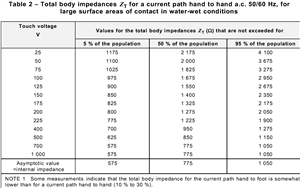
gkenyon:ProMbrooke:gkenyon:ProMbrooke:
Thats where CPCs come in, in that they would cause the fuse or MCB to open in 0.2 seconds or less.Doesn't that happen anyway ... in TN systems where the loop impedance ensures operation in 0.1 s?
The issue being, that, in TN-S systems (no RCD), you're limited in circuit length with Type C mcb's.
Also, interested where 25 V comes into the equation here? To do that, you've got to oversize the cpc, not undersize it ... and even then, may not be possible in TN-S due to the effect of the distributor's cpc ?
It does, but going by table 41.1 we are allowed a loop Z high enough to cause 0.4 seconds disconnection.
Type A, B, or C MCBs, fuses, or the like you are always limited in circuit length be it voltage drop or should the RCD become inoperative.
25 volts is the highest touch voltage under infinite time allowed by the IEC in wet locations according to Table C.1 in IEC 61200-413. Where higher touch voltage are found, disconnection is required. At 125 volts 0.17 seconds is required. With a reduced size CPC, even faster times are required.
IEC 61200-413 is now inactive. It's not a current standard.
As I've said repeatedly, you'd need to refer to something more up-to-date.
Latest versions of IEC 61140 and IEC 60479 series.
IEC 60479 still gives similar results. 30% decrease from 900 is 630 ohms. So assuming 630 ohms vs 500 ohms take us to around 0.2 seconds vs 0.17 seconds in the old standard.

gkenyon:ProMbrooke:gkenyon:ProMbrooke:
Thats where CPCs come in, in that they would cause the fuse or MCB to open in 0.2 seconds or less.Doesn't that happen anyway ... in TN systems where the loop impedance ensures operation in 0.1 s?
The issue being, that, in TN-S systems (no RCD), you're limited in circuit length with Type C mcb's.
Also, interested where 25 V comes into the equation here? To do that, you've got to oversize the cpc, not undersize it ... and even then, may not be possible in TN-S due to the effect of the distributor's cpc ?
It does, but going by table 41.1 we are allowed a loop Z high enough to cause 0.4 seconds disconnection.
Type A, B, or C MCBs, fuses, or the like you are always limited in circuit length be it voltage drop or should the RCD become inoperative.
25 volts is the highest touch voltage under infinite time allowed by the IEC in wet locations according to Table C.1 in IEC 61200-413. Where higher touch voltage are found, disconnection is required. At 125 volts 0.17 seconds is required. With a reduced size CPC, even faster times are required.
IEC 61200-413 is now inactive. It's not a current standard.
As I've said repeatedly, you'd need to refer to something more up-to-date.
Latest versions of IEC 61140 and IEC 60479 series.
IEC 60479 still gives similar results. 30% decrease from 900 is 630 ohms. So assuming 630 ohms vs 500 ohms take us to around 0.2 seconds vs 0.17 seconds in the old standard.
We're about to take you to the IET registration website. Don't worry though, you'll be sent straight back to the community after completing the registration.
Continue to the IET registration site